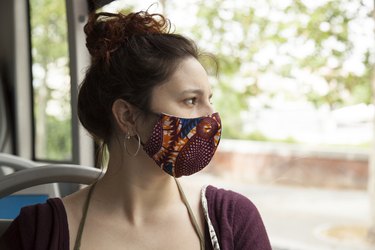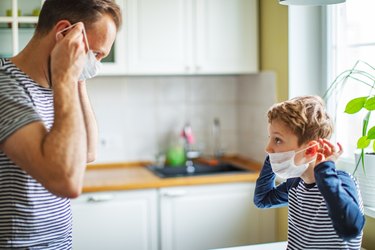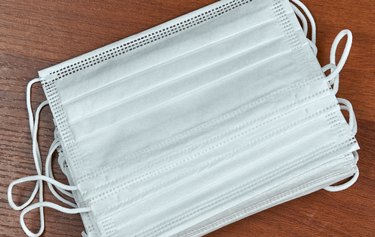
The Centers for Disease Control and Prevention (CDC) may have relaxed some mask-wearing guidelines for vaccinated people, but "No shoes, no shirt, no mask, no service" remains the mantra for unvaccinated people and certain spaces for all across the country.
That's because wearing a mask is the most effective technique to stop the spread of COVID-19, according to a June 2020 analysis in the Proceedings of the National Academy of Sciences.
Video of the Day
Video of the Day
The protective value of masks, of course, partly depends on how they're used. If you're unvaccinated and reckless about masking up or clumsy when handling or removing your mask, you could be putting yourself and others at risk.
So, what are the most common face-mask mishaps, and how can we avoid them? We turned to specialists in aerobiology, infectious disease and public health for a reality check on best practices for the use of face coverings and where we all may be falling a bit short.
Get tips on how to stay healthy, safe and sane during the novel coronavirus pandemic.
Mistake 1: Forgoing a Mask
Anyone ages 2 and older who is unvaccinated should wear a cloth face covering around people outside of their household, per the CDC. (Fully vaccinated people can go without a mask in many cases, except where required.)
It's particularly important "in high-risk places where it's difficult to socially distance," Kate Grabowski, PhD, an assistant professor in the department of pathology at Johns Hopkins University in Baltimore, tells LIVESTRONG.com. There's probably not a lot of benefit to wearing a mask if you're, say, running alone in the woods, regardless of your vaccination status, according to the CDC.
The mask acts as a barrier, preventing infectious droplets from landing on other people or making their way into the air, according to the CDC. This is key, because COVID-19 is spread most often through respiratory droplets or aerosols (as opposed to shared surfaces), and the closer together people are, the higher the risk of transmission, according to a September 2020 review in the Annals of Internal Medicine.
Tip
Remember, unvaccinated people should wear masks even if they don't feel sick: 40 percent of people with SARS-CoV-2, the virus that causes COVID-19, never show symptoms of the illness, per the CDC.
The potential for airborne spread of COVID-19 is particularly worrisome in enclosed, crowded or poorly ventilated spaces, according to a July 2020 commentary in Clinical Infectious Diseases signed by more than 200 scientists.
"Handwashing and social distancing are appropriate, but in our view, insufficient to provide protection from virus-carrying respiratory microdroplets released into the air by infected people," the authors caution.
Wearing a cloth mask in such venues won't eliminate infectious emissions, Donald K. Milton, MD, DrPH, professor of applied environmental health at the University of Maryland School of Public Health in College Park, Maryland, and a co-author of the commentary, tells LIVESTRONG.com. "But if everybody's doing it and if you ventilate those spaces, the amount of exposure will go way down, the risk of infection goes way down and we won't have these super-spreading events."
"Make sure you always have one handy that you travel with," adds Kendra McMillan, RN, MPH, senior policy advisor for nursing practice and work environment at the American Nurses Association in Silver Spring, Maryland. "When you're out and about, it needs to become part of your routine: You have your keys, you have your phone, you have your mask."
Related Reading
Mistake 2: Wearing a Mask That Doesn't Fit

It's almost impossible to avoid images in the news or real-life encounters with adults and kids wearing masks with their nostrils exposed. Sometimes you'll see people whose masks slip down as they're speaking.
"Make sure your nose, your mouth and your chin are covered when wearing your mask."
Proper fit is key, McMillan says. "It shouldn't be so tight that it's impeding your ability to breathe, but it also should have a fit along the face so that it can stay in place," she tells LIVESTRONG.com.
"You want to make sure your nose, your mouth and your chin are covered when wearing your mask," McMillan says.
Indeed, the CDC says wearing a mask that fits tightly to your face may make it up to 95 percent more effective. You can get a tighter fit by layering a cloth mask over a surgical mask, knotting the ear loops and tucking in the sides of your surgical mask or wearing a mask fitter or nylon covering over top of your mask.
Mistake 3: Touching or Tugging at Your Mask
Remember, mask wearing is primarily intended to prevent the spread of infection to others. So, if you're constantly pulling it off, that "defeats the entire purpose," Grabowski notes. "If you take off your mask and then you cough or start talking, you could potentially be spreading COVID-19."
Keeping that face covering in place limits the amount of virus that you emit into the local environment.
Touching the front of the mask also poses a risk to the wearer. If the outer surface has been exposed to viral particles and you touch the mask and then touch your face, "you could potentially infect yourself," Grabowski says.
Mistake 4: Skipping Soap and Water (or Hand Sanitizer)

Before putting on your mask, the CDC recommends washing your hands, and, if you happen to touch the mask while you're out, you should wash up again. If you're dining out, you'll have to remove your mask to eat, so don't forget to bring along hand sanitizer.
Once you're home, untie the strings or remove the ear loops from your ears, fold the outside corners of the face covering together and place the item in the laundry, per the CDC. And wash your hands immediately.
Related Reading
Mistake 5: Not Washing Your Cloth Mask
"Would you wear the same pair of underwear over and over again?" Grabowski asks. (Eww, no!) The same is true of cloth masks, she says. Ideally, masks (and underwear) should be washed after every use.
How to Wash and Dry Your Mask
In a washing machine: Toss it in with your regular laundry at the warmest temperature setting that makes sense for the type of fabric you’re washing, per the CDC.
By hand: Combine 4 teaspoons of bleach with a quart of water, and wash the mask in that mixture, per the CDC. Or, use soap or detergent, along with hot water, according to the World Health Organization (WHO).
Dry: Let your mask dry on high or air dry, preferably in direct sunlight.
Alternatively, you can stretch out your laundering cycles with this hack: Buy seven masks, one for each day of the week, and hang them in a warm place after use, Dr. Milton suggests. By day eight, the first mask in the rotation will be ready to use again. SARS-CoV-2 only lives on surfaces for a matter of hours to days, according to an April 2020 report in The New England Journal of Medicine.
Another reason to wash your mask is to ward off breakouts, according the Mayo Clinic. By giving your mask a good cleaning after wearing it, you'll remove the skin cells and oil that can cling to the mask and potentially cause skin irritations and acne. Opt for a fragrance-free detergent when you wash your mask, per the Cleveland Clinic.
Mistake 6: Reusing a Disposable Mask

You can buy stacks of non-medical grade face masks online for everyday use. They're lightweight and disposable, but are they safe to reuse?
Experts say it's probably not a great idea. The filtering layers can degrade. The ear loops can stretch out. They get soiled.
"If they're single use and disposable, they're disposable after a single use," Grabowski says. "What we don't want is for masks to become a risk for someone."
Mistake 7: Assuming Your Scarf or Neck Warmer Is Enough Protection
Yes, scarves and neck gaiters can cover your mouth and nose, but that doesn't mean they offer the same protection as a mask. In fact, there's some evidence that they might do the opposite.
In an August 2020 study in Science Advances, researchers took a video as a person spoke in the direction of a box rigged with a laser beam and camera while wearing a face covering, then counted the number of droplets they produced. Out of 14 types of face coverings, bandanas and neck gaiters allowed the most droplets to escape, while professionally fitted N95 masks, surgical masks and cotton cloth face masks were the most successful at stopping droplets.
Gaiters in particular led to large droplets dispersing into smaller ones. Because these smaller droplets stay aloft longer, "the use of such a mask might be counterproductive," according to the study.
Of course, this is only one small study, and more research needs to be done before we can draw a definite conclusion. But for now, opting for a cloth or surgical mask instead of these types of face coverings seems best.
Concerned About COVID-19?
Read more stories to help you navigate the novel coronavirus pandemic:
- Centers for Disease Control and Prevention: "About Cloth Face Coverings"
- CDC: "Considerations for Wearing Cloth Face Coverings"
- CDC: "COVID-19 Pandemic Planning Scenarios"
- CDC: "How to Wear Cloth Face Coverings"
- The New England Journal of Medicine: "Aerosol and Surface Stability of SARS-CoV-2 Compared With SARS-CoV-1"
- Cleveland Clinic:"Should I Wear a Face Mask in the Car?"
- CDC: "When to Wear Gloves"
- Clinical Infectious Diseases: "Is It Time to Address Airborne Transmission of COVID-19"
- Proceedings of the National Academy of Sciences: "Identifying airborne transmission as the dominant route for the spread of COVID-19"
- World Health Organization: "How to Wear a Non-Medical Face Mask Safely"
- Mayo Clinic: "Treating skin irritations from wearing face masks"
- Annals of Internal Medicine: "Transmission of SARS-CoV-2: A Review of Viral, Host, and Environmental Factors"
- CDC: "Maximizing Fit for Cloth and Medical Procedure Masks to Improve Performance and Reduce SARS-CoV-2 Transmission and Exposure, 2021"
- Cleveland Clinic: "The Struggle With Maskne Is Very Real"
- CDC: "When You’ve Been Fully Vaccinated"
Is this an emergency? If you are experiencing serious medical symptoms, please see the National Library of Medicine’s list of signs you need emergency medical attention or call 911.